Lunar New Year Recipes from Chef Jet Tila
- by bonappetit

Bon Appétit has long partnered with Chef Jet Tila to train our teams in authentic Chinese, Thai, and pan-Asian cooking techniques. This Lunar New Year, we’re thrilled to partner with Jet to provide a virtual cooking demonstration featuring Scallion Pancakes with Ginger Dipping Sauce. These recipes are also included in a training manual Jet developed for our chefs called “China’s Four Influential Cuisines,” which covers China’s diverse regional food traditions. We think you’ll enjoy learning from Jet as much as we have.
North (The Food in Peking): Wheat flour is used to make noodles, steamed buns, dumplings and pancakes. Dishes in general are much more plain, solid and nourishing. Mutton and lamb are popular. The strong flavors of leeks, onions and garlic feature largely. The most popular vegetable in this region is the Chinese cabbage, which can be stored over winter.
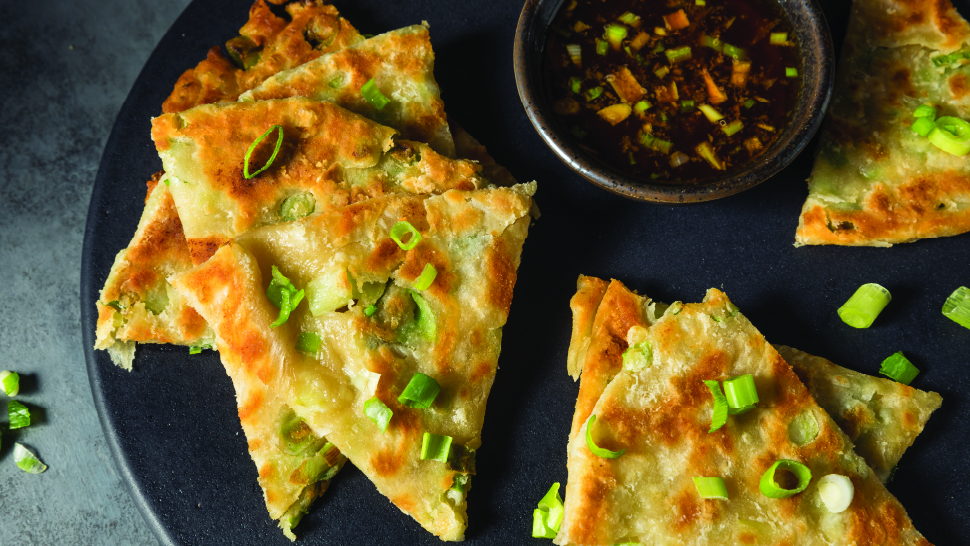
Scallion Pancakes “Cong You Bing” with Ginger Dipping Sauce – Northern
24 Servings
These thin breads are crisp and brown on the outside. Yields 12 round pancakes, cut each pancake into 6 pie shaped wedges, 3 pieces per serving, or 72 pieces for hors d’oeuvres.
Ingredients
4 cups unbleached all-purpose flour
1½ teaspoons salt
1½ cups boiling water, plus 2 tablespoons cold water
6 tablespoons vegetable oil
2 tablespoons oriental sesame oil
8 spring onions (scallions), finely chopped
Canola oil for shallow frying
- Mix flour and salt together in a large bowl; pour in boiling water and quickly mix together until water is absorbed. Work cold water, about 1 tablespoon at a time, into flour mixture just until dough forms.
- Knead dough for 10 minutes. Roll into a smooth even thick log. Cover bowl with plastic wrap and let dough rest for 40 minutes.
- Form dough into a roll and divide into 12 equal portions. Roll each portion on a lightly floured surface into thin pancakes about 8-9 inches in diameter.
- Combine both kinds of oil and brush a thin layer on top of pancake. Sprinkle with 2 teaspoons chopped spring onions.
- Starting at the bottom edge, roll pancake up into a loose tube, press ends to seal and coil up the roll like a snail. Tuck the end into the middle. Flatten with your hand and roll again on a lightly floured surface to a smaller pancake than the first, about 5 inches in diameter and 1/4 inches thick. Repeat until all the pancakes are rolled.
- Heat a heavy frying pan over medium-high heat until a bead of water evaporates on contact. Add just enough oil to cover the pan with 1/8th layer of oil. When hot add pancake, turn heat medium and cook until the bottom is golden and slightly crusty about 3 minutes, then turn pancake over and cover for another 3 minutes or until pancake is golden brown on both sides. Do not have heat too high or the pancakes will brown before the center is cooked.
- Cut pancakes into 6 triangular pieces. Serve warm.
Ginger Dipping Sauce
Ingredients
3 tablespoons light-sodium soy sauce
1 tablespoon brown sugar
2 teaspoons minced fresh ginger
2 teaspoons rice vinegar
1/2 teaspoon sesame oil
1/8 teaspoon crushed red pepper flakes
- Whisk together until evenly blended. Cover and set upside until read to serve.
South (The Food in Canton): Rice, fruit, and vegetables enjoy four seasons, while plentiful feed for livestock means that high-quality meat and poultry is abundant. And the long coastline gives access to the rice fishing grounds of the South China Sea with their enormous variety of fish and seafood. They prefer cooking methods such as steaming or poaching, which preserve the natural flavors and colors. The Cantonese have also developed a cooking method called Char Siu, which can be translated as barbecue roasting. This involves marinating meat, especially pork, for some time and then roasting it quickly in a very hot oven. Cantonese cooking specializes in the quick stir-frying of vegetables, which helps to retain color, flavor and nutrients. Spinach, cabbage, peppers, broccoli and dried mushrooms are widely used.
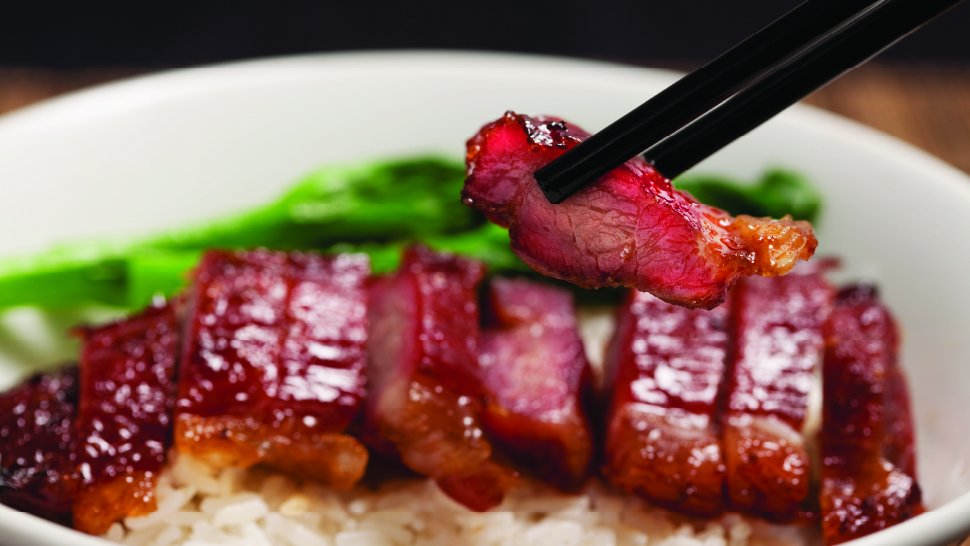
Chinese BBQ Pork – Pork Char Siu – Southern
Chinese-style oven roasted pork
24 Servings
Ingredients
1 oz. fresh ginger root
1/3 cup 2 tsp. oyster sauce
1 tsp. Chinese five spice
¾ cup soy sauce
1/3 cup, 2 tsp. granulated sugar
1/2 cup hoisin sauce
1/2 cup ketchup
8 lbs. pork shoulder, raw
1/3 cup, 2 tsp. honey
¼ cup sherry cooking wine
Prepare marinade
- In bowl, stir together sherry, sliced ginger root, oyster sauce, five-spice powder, soy sauce, white sugar, hoisin sauce, honey and ketchup.
- Cut pork into 5″ x 2″ inch strips. Place strips flat in a shallow baking dish. Pour marinade over pork strips.
- Let pork marinate at least 6 hours in refrigerator.
- Drain, reserving marinade. Roast the pork
- Bring reserved marinade to a boil and gently simmer for 5 minutes. Set aside. Preheat oven to 350°F.
- Carefully place pork strips on a roasting rack above roasting pan so all sides are exposed to heat. Roast for 20 minutes, and then check temperature. If necessary, cook in 5-minute increments until meat is 165°F degrees.
- Remove from heat and let cool before slicing into ¼ inch pieces (or as called for in a sub recipe). Ladle sauce over sliced pork before presenting.
East (The Food in Shanghai): Both wheat and rice are grown here, as well as barley, corn, soy beans and an abundance of vegetables. Peanuts produce the oil which is largely used in cooking. The Yangtze is the greatest rice-producing region in China, and it follows that all rice-based products exist in abundance among them rice wine, used extensively in dishes. Chekiang province, south of the Yangtze, is known as the land of rice and fish, and it is one of the wealthiest and most heavily populated regions of China. Shanghai, on the Yangtze estuary, is the largest city in China, and one of the most cosmopolitan, being the center of China’s trade and industry. Its cuisine is noted for its use of red-cooking, with dark soy sauce, and its lavish use of sugar, which produces rich, sweet dishes with exquisite flavors and appearance.
Strange Flavor Eggplant – Eastern
Strange Flavor Eggplant has a long history in Chinese American cuisine and is directly taken, and translated, from the self-same dish in China, which is commonly served in the region surrounding Shanghai. The Chinese name of the dish literally translates to “mysterious flavor eggplant” or “unusual flavor eggplant,” and is also commonly translated to “strange flavor eggplant,” which connotes the unique flavor of the dish that falls outside of the five main flavors of Chinese cuisine: salty, sweet, sour, savory, and umami.
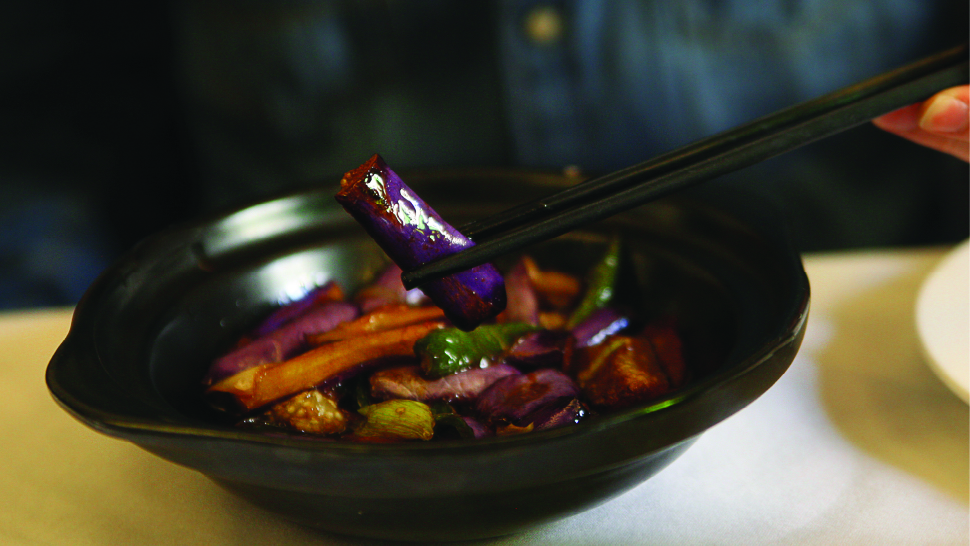
20 Servings
Ingredients
2½ lbs. large eggplant (Italian or globe)
¼ c + 1 tablespoon canola oil
1¼ teaspoon Japanese sesame oil
2½ tablespoons finely minced garlic
2½ tablespoons finely minced fresh ginger
½ c + 2 tablespoon thinly sliced green and white scallion rings
¾ cup dried red Chile flakes
Sauce:
7½ tablespoons soy sauce
7½ tablespoons packed brown sugar
2½ teaspoons unseasoned Japanese rice vinegar
2½ tablespoons hot water
Garnish: Wontons or Croutons
Thinly sliced green and white scallion rings
- Preheat convection oven to 425 °F
- Prick eggplant well in several places with a fork and remove leaves. Bake on a baking sheet, turning once, until fork-tender, 20 to 40 minutes, depending on the size. Remove the eggplant and slit it lengthwise to speed the cooling. While still warm, remove stem ends and peels. Cube the pulp, then process with any thick baking juices until nearly smooth. Combine the aromatics in a small dish.
- Combine the sauce ingredients in a small bowl, stirring to dissolve the sugar.
- Heat a wok or large heavy skillet over high heat until hot enough to evaporate a bead of water on contact. Add canola oil, swirl to glaze the pan, reduce the heat to moderately high. When hot enough to foam a scallion ring, add the garlic, ginger, scallions and chili flakes. Stir-fry until fragrant, about 15 seconds, adjusting the heat so they sizzle without scorching. Add the sauce ingredients and stir until simmering. Then add the eggplant, stir well to blend, and heat through. Remove from the heat, then taste and adjust with a dash more of Chile
West (The Food in Sichuan): Fruit and vegetables grow in abundance, as well as edible mushrooms and fungi. Spices grow in abundance here too, particularly chilies and the famous Sichuan peppercorns. Sichuan food is noted for being hot, spicy and strongly flavored. Chilies are used in large quantities, usually unseeded, as well as pungent flavored vegetables such as garlic, onions and spring onions. They also enjoy the aromatic, nutty flavor of peanuts, sesame seeds, cashews, walnuts and pine nuts, which are often found incorporated into dishes. A favorite way of cooking it is by stir-frying, often until it is quite dry, giving it the characteristic dry ‘chewy’ texture. Steaming is also popular, and here the meat is usually first coated with ground rice, producing a rich, thick gravy.
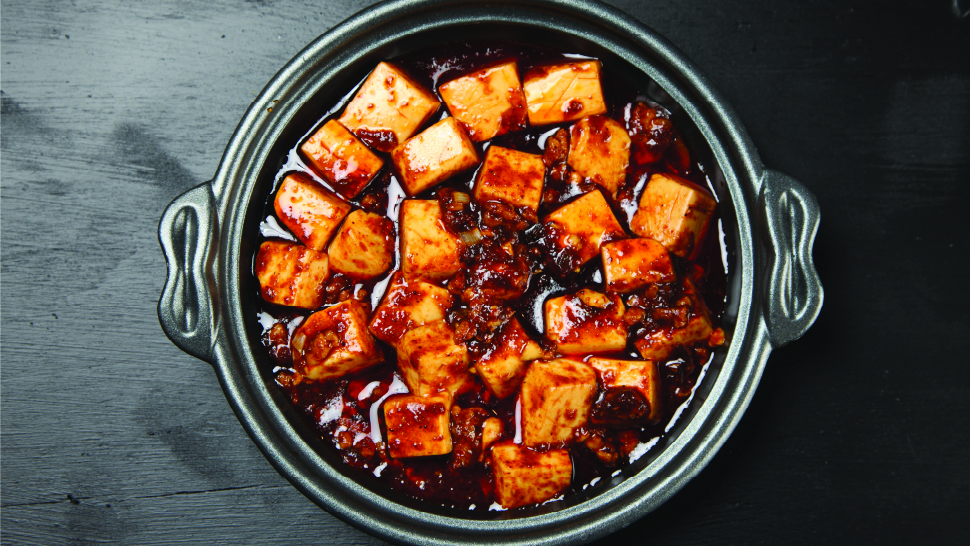
Mapo Tofu – Western
Mapo tofu is one of the most famous dishes in Chuan Cuisine with a history of more than 100 years. Ma (麻) describes a spicy and hot taste, which comes from the chili. The milky tofu is enriched with brownish red ground pork and chopped green onion.
20 Servings
Ingredients
5 lbs. firm tofu cut into 1/2 inch square cubes
1 lb. 4 oz. ground pork (optional)
1 teaspoon salt
5 tablespoons chili garlic sauce (or more, depending on your preference)
2½ cups chicken stock
15 green onions, chopped
1 tablespoon black bean paste
Marinade
½ cup tablespoon tapioca starch
½ cup 2 tablespoons soy sauce
Sauce
5 tablespoons cornstarch
½ cup 2 tablespoons water
5 tablespoons sweet soy sauce
5 tablespoons oyster sauce
- Mix Sauce ingredients together in a small container and reserve. Mix marinade ingredients and marinate pork for about 20 minutes.
- Heat wok and add oil. When oil is ready, add the marinated pork. Stir-fry pork until the color darkens. Add salt and stir. Add the black bean paste and chili paste, then the stock, tofu, and leek or green onions.
- When the mixture comes to a boil add the sauce while stirring constantly. When mixture thickens, remove from heat and serve immediately.
- Serve with freshly ground Sichuan pepper.
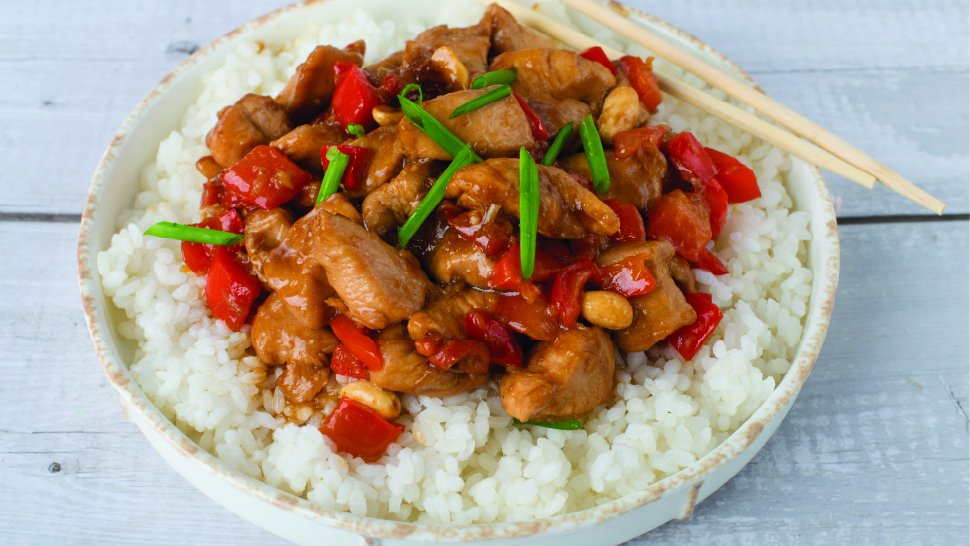
Spicy Stir Fried Chicken, Peanuts, Dried Chilies & Peppers – Western
25 Servings
Ingredients
1¾ lb. Sichuan sauce
8 lb. chicken in marinade
2 tablespoons canola oil
12 oz. green bell peppers, battonet-cut
1 lb. red bell peppers, battonet-cut
1 lb. onions, battonet-cut
2/3 oz. red chili peppers, dried
4 oz. dry roasted peanuts
- Prepare the Chicken in Marinade and Sichuan Sauce according to the recipes. Hold cold. Before service or batching cooking: Steam or boil chicken for 1 to 2 minutes or until tender. Cool completely.
- Use dried chile de arbol and remove the stems but leave whole. Set aside.
- Heat pan and add oil, sauté bell pepper and onions in oil. Add chicken, green onions, chile de arbol and peanuts. Toss to combine and then add Sichuan Sauce. Continue tossing until everything is well coated and hot.
Chicken in Marinade
Simple marinade adds moisture to chicken before stir frying
22 Servings
Ingredients
5 lb. skinless, boneless chicken thigh
¼ oz. baking soda
¼ oz. kosher salt
1½ oz. cornstarch
2 cups water
5 oz. canola oil
Slice chicken into thin 2 inch long pieces and place in large container.
Combine all other marinade ingredients in a separate bowl. Pour marinade over chicken and mix together until evenly distributed. Allow the marinade to be absorbed for 20 minutes, and then remove using a slotted spoon. Do not drain all of the liquid.
Notes:
2 cups of marinade will remain after pulling out the chicken for every 10 pounds of chicken.
For 10 # of raw chicken final weight is 11 #, 8 oz. after the marinade is absorbed into the chicken.